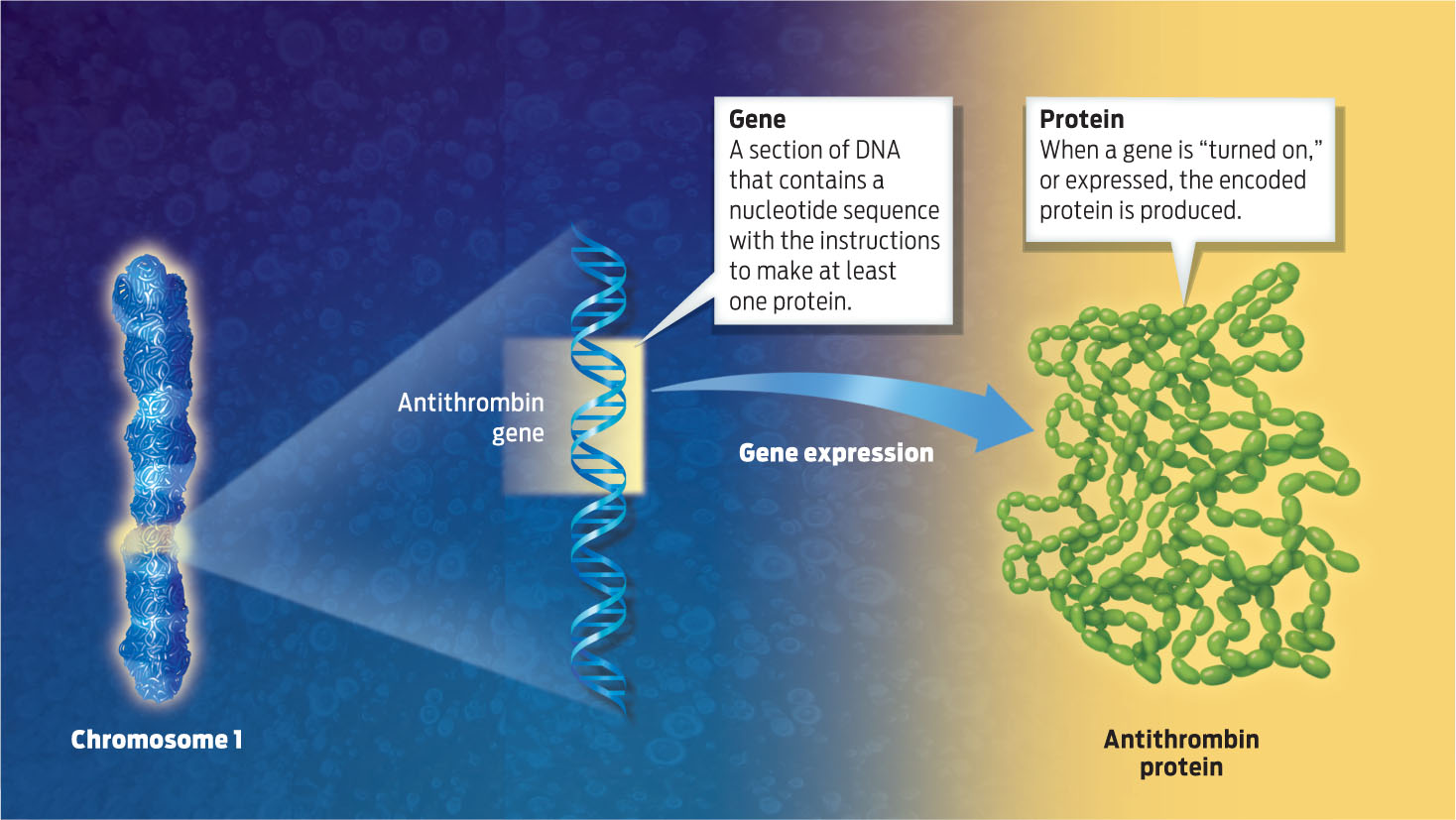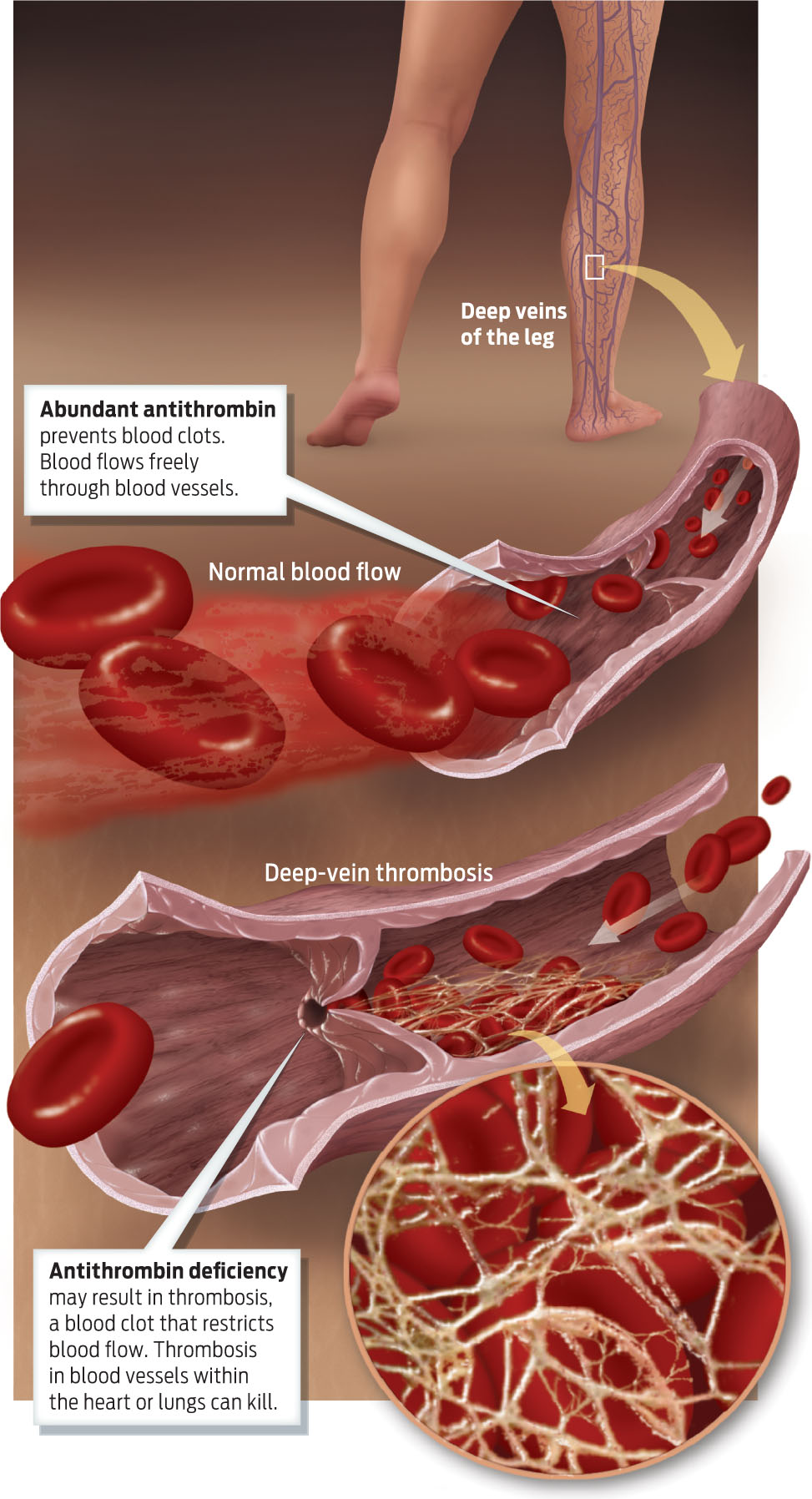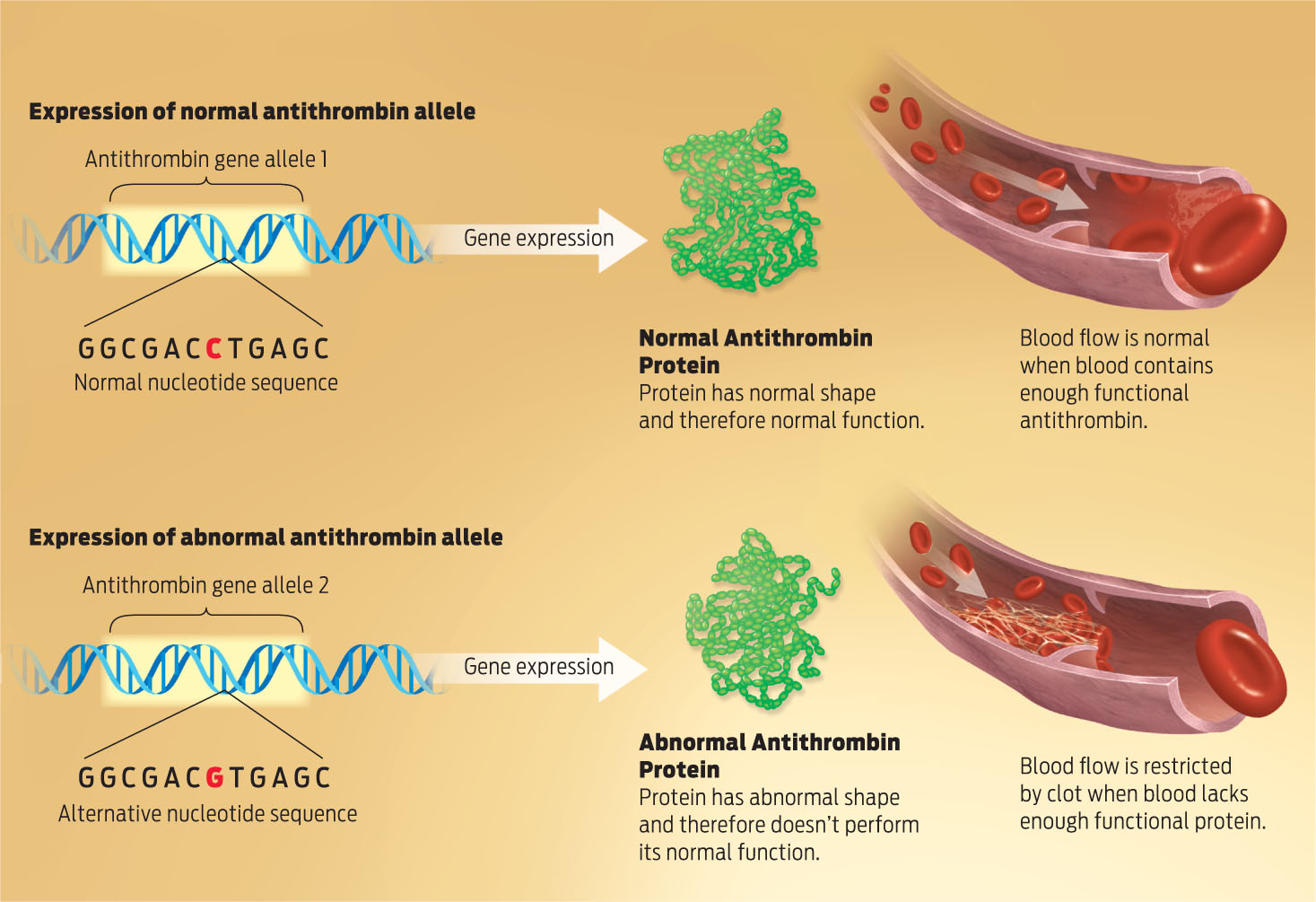PROFILE OF A PROTEIN
PROTEIN A macromolecule made up of repeating subunits known as amino acids, which determine the shape and function of a protein. Proteins play many critical roles in living organisms.
AMINO ACIDS The building blocks of proteins. There are 20 different amino acids.
Antithrombin is a protein. Recall from Chapter 2 that proteins are one of the four main macro-molecules that make up cells. Proteins are the cell’s do-it-all molecules. They help us perform countless tasks, everything from contracting our muscles to fighting infection. Some proteins are hormones, important chemical messengers in the body (see Chapter 30); others are enzymes, speeding up the rate of chemical reactions (see Chapter 4); still others act as transporters–for example, the protein hemoglobin transports oxygen throughout the body (see Chapter 28); and the antibodies of our immune system help keep us healthy (see Chapter 31). The list is virtually endless: think of almost any feature of a living organism, and one or more proteins plays a role. Because proteins are so critical to cell function, most drugs are either chemicals that interact with specific proteins or, like antithrombin, are proteins themselves.

All proteins are made of the same building blocks called amino acids. There are 20 different amino acids found in proteins. All amino acids have the same basic core structure, but each also has a unique chemical side chain that distinguishes one amino acid from another. To form proteins, amino acids bind together in linear chains, much like beads on a string. The human antithrombin protein is a chain of 432 amino acids. Many human proteins are about this size, but chain lengths vary from just a few amino acids to many thousands. The longest human protein, titin (involved in muscle contraction) is a single chain of 34,350 amino acids. The shortest known protein is insulin, which helps regulate blood sugar: it has only 51 amino acids.
165
In cells, amino acid chains fold into a distinct three-dimensional shape, or conformation. Some proteins, like antithrombin, are made up of just one folded chain. Others, such as the antibodies of our immune system, or the hemoglobin that carries oxygen in our red blood cells, are made up of more than one folded amino acid chain bound together.
The particular sequence of amino acids in a chain determines how the chain will fold. Interactions between amino acid side chains, and between these side chains and the surrounding water, influence the precise folding pattern. Much like an oil droplet in water, hydrophobic amino acid side chains tend to clump together on the inside of a protein, while hydrophilic amino acids face out toward water, forming a distinct three-dimensional shape. This folded shape is important because shape is what ultimately determines how a protein behaves. In other words, the order of amino acids determines a protein’s shape, and the protein’s shape determines its specific function (INFOGRAPHIC 8.1) .

166
 I think it’s going to be a wave of the future for a lot of these difficult-to-get blood products.
I think it’s going to be a wave of the future for a lot of these difficult-to-get blood products.
— MICHAEL PAIDAS
GENE A sequence of DNA that contains the information to make at least one protein.
If the amino acid sequence of the protein changes, the shape of the protein may change. This differently shaped protein may not be able to do its job. For example, if a protein’s normal function is to bind to another molecule and the shape of the binding site changes, it may no longer be able to bind to that molecule.
GENE EXPRESSION The process of using DNA instructions to make proteins.
Where do proteins come from? The instructions to make proteins are encoded in our DNA–in our genes. A gene is a sequence of DNA that contains instructions for making at least one protein. (A few genes make RNA as their final product instead of proteins, but we’ll stick to protein-coding genes here.) Genes are found along the length of chromosomes, with each chromosome carrying a unique set of genes.
The synthesis of a protein from the information encoded in a gene is called gene expression. When a cell is making the protein encoded by that gene, the gene is said to be “expressed.” In essence, genes provide the blueprint for building proteins.
The antithrombin gene, for example, is found on chromosome 1 and holds instructions to make a chain of 432 amino acids that folds into a three-dimensional protein called antithrombin. When cells express the antithrombin gene, it means they produce the antithrombin protein (INFOGRAPHIC 8.2) .
Chromosomes have many genes along their length. Each gene contains instructions to make at least one protein.

Antithrombin is an important protein that helps prevent blood clots (thrombosis). The antithrombin gene is expressed by cells in the liver, which then release antithrombin protein into the bloodstream.

167
In the body, antithrombin protein helps prevent blood from clotting improperly. Antithrombin is produced by cells in the liver and released into the blood. When antithrombin is present, it inactivates enzymes that promote blood clotting. By preventing blood from clotting in the wrong place at the wrong time, antithrombin helps prevent a stroke or a heart attack.
Some people, however, inherit a genetic defect that causes antithrombin deficiency. Inherited antithrombin deficiency isn’t rare–about 1 in every 5,000 people in the United States is born with the inability to produce adequate amounts of this protein. People with too little or no functional antithrombin carry a high risk of developing blood clots inside blood vessels, a condition called thrombosis, and consequently they sometimes require antithrombin transfusions to prevent these vessel-blocking clots from forming (INFOGRAPHIC 8.3) .
ALLELES Alternative versions of the same gene that have different nucleotide sequences.
When people inherit antithrombin deficiency, it doesn’t mean they lack the antithrombin gene. Rather, it means that one or both copies of their antithrombin gene are defective. Remember that most human cells have two copies of every gene (see Chapter 7). These copies can either be identical in nucleotide sequence, or slightly different. Different versions of the same gene, with different nucleotide sequences, are called alleles. All genes, including antithrombin, have multiple such alleles.
You can think of alleles as being like words with different spellings. Some of these variant spellings are harmless (for example, color, colour; theater, theatre). Others change the meaning of the word entirely (here, hear; read, red). A change in one letter–one nucleotide–is sometimes enough to alter the function of a protein, or make it nonfunctional. Having a nonfunctional protein is as harmful as not having one at all. In most cases of antithrombin deficiency, only one of the two alleles makes a functional protein. The amount of protein produced from this single functional allele is simply not enough to prevent improper clotting. Hence, antithrombin deficiency (INFOGRAPHIC 8.4) .
Versions of a gene with different nucleotide sequences are called alleles. Alternative nucleotide sequences may code for a protein with a different shape.

168
People with inherited antithrombin deficiency usually take medication to thin their blood and prevent clots. At times when the risk of clots is high–during surgery or pregnancy, for example–they receive antithrombin treatment.
The problem is that it takes 90,000 blood donors to produce 1 kg of antithrombin, enough to treat about 300 patients, which means the drug is often scarce; hospitals can and do run out. A single genetically modified goat, on the other hand, can produce the same amount in her milk in just 1 year, according to rEVO Biologics, ensuring a more stable supply.